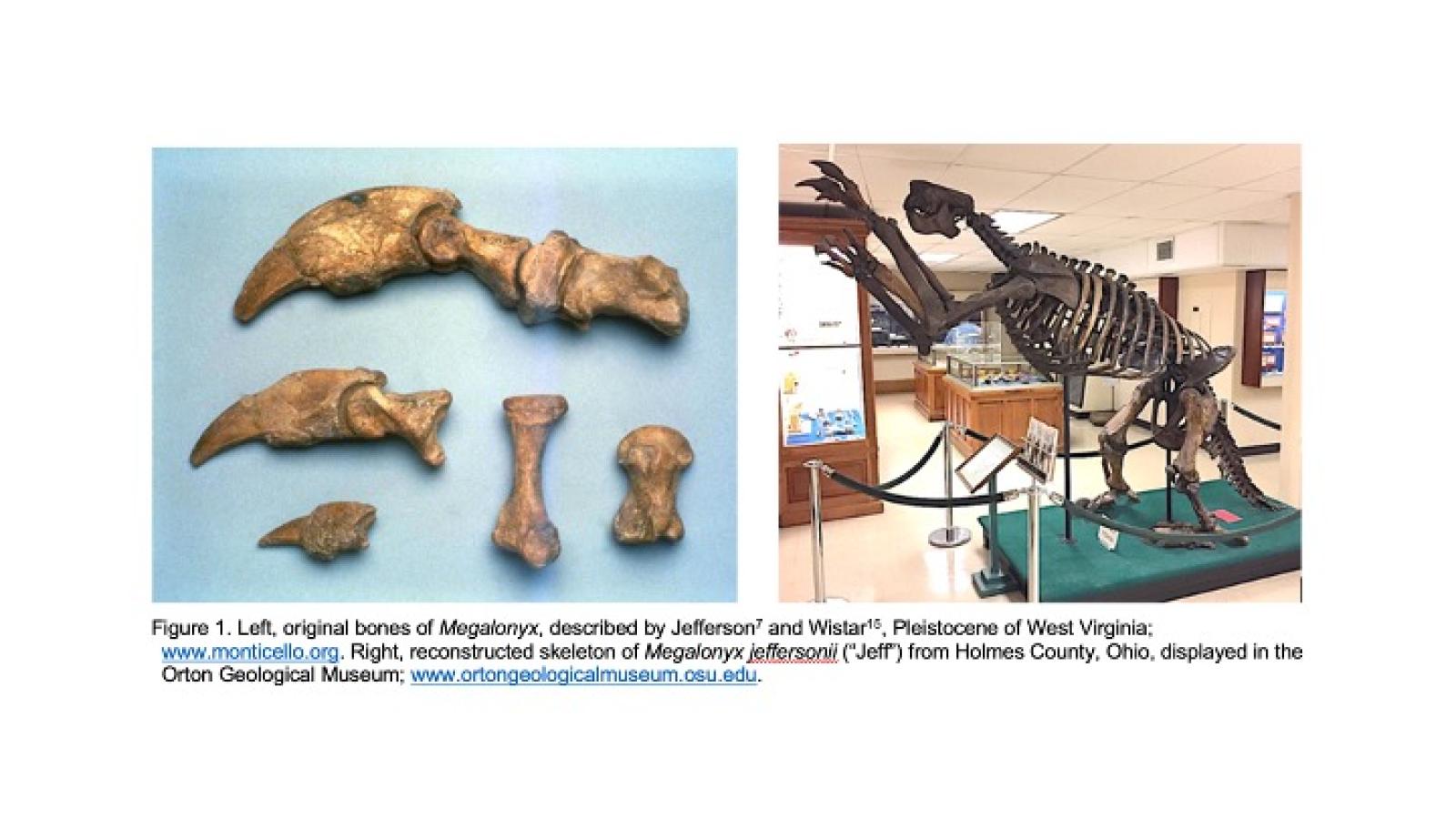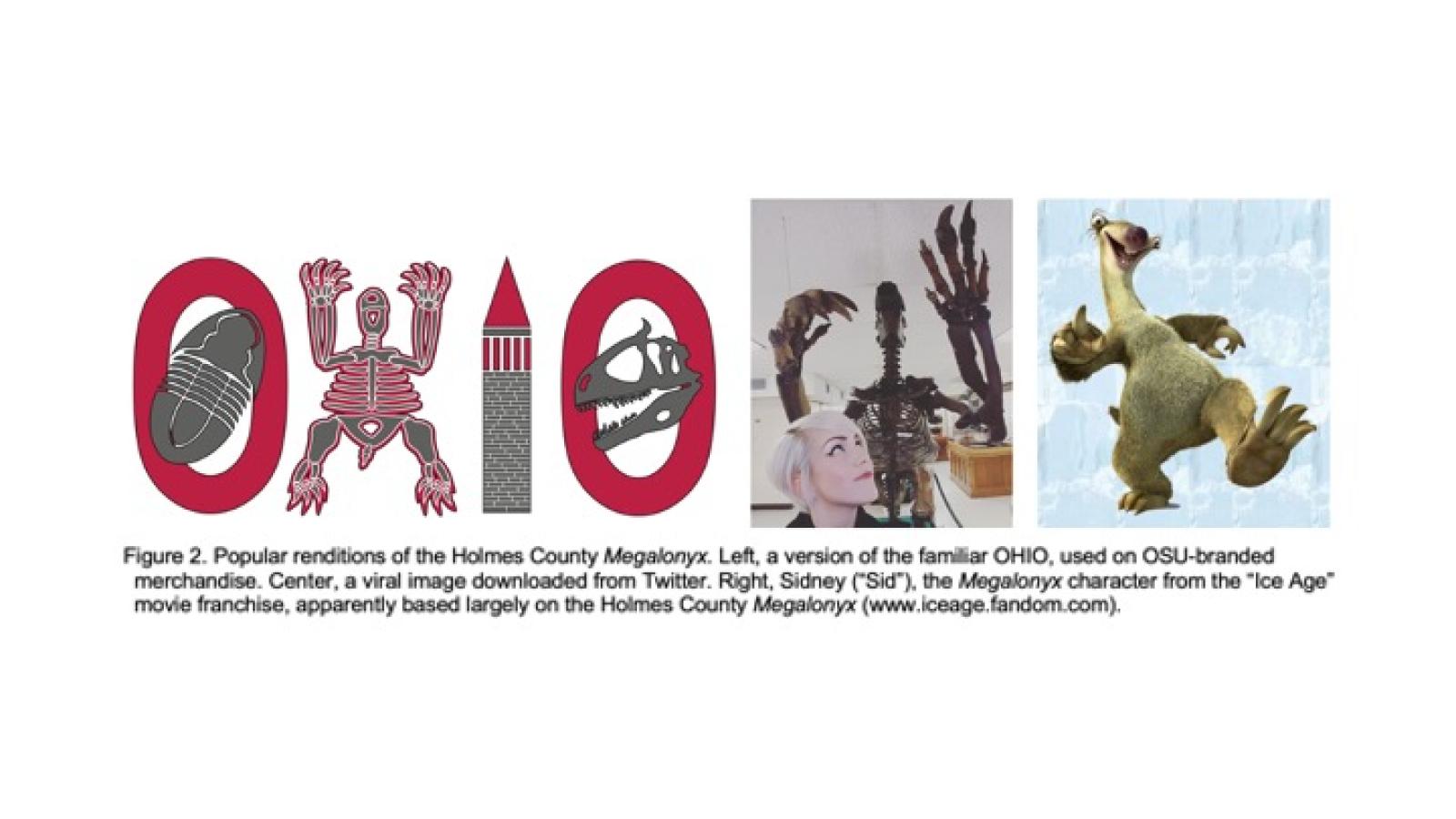The Megalonyx Project: Science Education Through Restudy of a Landmark Scientific Discovery
BACKGROUND
On March 10, 1797, Thomas Jefferson presented “A Memoir on the Discovery of certain Bones of a Quadruped of the Clawed Kind in the Western Parts of Virginia” to the American Philosophical Society. Published in 1799, the paper7 includes the naming of the first genus of fossil animal, Megalonyx (“giant claw”) from the USA. Together with an accompanying paper by Caspar Wistar15 describing the fossil material, these papers mark the beginning of the science of paleontology in America1,13,14.
Jefferson named Megalonyx from claw and limb bones (Figure 1, left). Over the next 90 years, additional material from Pleistocene (Ice Age) deposits in the United States added incrementally to scientific and public understanding of the giant ground sloth8. Along with other emblematic Pleistocene mammals such as mammoths and mastodons, Megalonyx is now extinct. Extinction apparently occurred in the midst of global climatic change associated with deglaciation of Northern Hemisphere continents, and expansion of human populations across these areas in the Pleistocene-Holocene2,4-6,9. In recent years, Megalonyx has been popularized across a variety of media platforms (Figure 2).
The first substantial skeletal remains of Megalonyx were found on a farm in Holmes County, Ohio, in December 18903,11. Approximately 30% of the skeleton was recovered before heavy snow thwarted further excavation. Enough material was recovered that missing parts could be reconstructed from modeling or casting other pieces. The fossils, donated to The Ohio State University, were mounted for display in 1896, and still stand in the Orton Geological Museum, (Figure 1, right). This ground sloth has the distinction of being the first mounted skeleton of Megalonyx9, and the oldest, mounted skeleton of a prehistoric animal in the USA.
The Megalonyx skeleton is one of Ohio State’s most distinctive and recognizable images. Images or descriptions of it span an array of scientific papers, promotional literature, artistic imagery, and digital media (e.g., Figures 1, right, 2). The skeleton is known informally as “Jeff,” after Thomas Jefferson. Viewed by >25,000 visitors annually, it is one of the most impactful teaching and outreach tools in the Orton Museum, although few know the skeleton’s backstory, or its significance in the annals of science.
The work envisioned includes using digital technologies and chemical analysis to extract new information from the skeleton. Adding to that will be non-destructive exploration of the original excavation site, which after more than 100 years, has been relocated by combining contemporary descriptions, maps, satellite imagery, and ground-level reconnaissance.
This work explores connections between science, technology, and history. It blends the talents of scientists (paleontologists, archaeologists), instructional designers, digital technologists, graphics art specialists, and classroom instructors. University students will participate in the research, and middle school students will interact in the discovery process as its components are digitally recorded and rendered. The project promotes science education, history of science, and an understanding of the role of technology in deciphering the past, to students and future leaders in science, technology, and digital arts.
PROJECT COMPONENTS
1. Research
1.A. Restudy of the mounted Megalonyx skeleton using new digital imagery.
1.B. Chemical analysis of bone fragments from the mounted skeleton.
1.C. Field study of the M. jeffersonii excavation site in Holmes County, Ohio, including drone imagery and ground penetrating radar.
2. Teaching/Outreach
Public-access maps and satellite imagery will be combined with digital images recorded at the excavation site to produce a set of combined media files that will be used in interactive, educational programs for university teaching and K-12 outreach programs (see Community Impact, below). The digital documentation will be available for public viewing on the Orton Museum’s website and its social media sites.
New, detailed 3D images of the mounted ground sloth skeleton will be produced. From these, 3D prints will be produced for use in teaching and outreach.
3. Community Impact
Jeff is one of America’s oldest scientific exhibits. The Megalonyx Project will add scientific and cultural context to this exhibit. A set of interactive, educational media files highlighting the use of technology in rediscovering, documenting, and analyzing a paleontological site will be produced, allowing the exploration process to be delivered into university and K-12 classrooms. The electronic media files, together with museum exhibits and 3D prints will ensure that the project has long-term impact.
The Orton Museum has partnered with the Columbus City Schools’ Columbus Gifted Academy in a STEM Enrichment Initiative for grades 6 to 8. The Megalonyx Project will be integrated into the program through virtual experiences. This will serve as a model for supplementing other academic curricula with the project’s electronic content.
Digital content will be used to upgrade and modernize the Orton Museum’s Megalonyx exhibit.
Partnering with the Ohio History Connection will allow the digital products to reach a wider audience.
REFERENCES
1Boyd, J.P. 1958. The Megalonyx, the Megatherium, and Thomas Jefferson’s lapse of memory. Proceedings of the American Philosophical Society, 102(5), 420-435.
2Brush, N., Redmond, B.G., Kardulias, P.N., Wiles, G., Burks, J., Greenfield, H.J., Yerkes, R.W., McDonald, H.G., Leone, K.L., Hannan, R., Donaldson, S., Dilyard, J. 2018. Description of an American mastodont (Mammut americanus) site in Morrow County, Ohio, and assessment of evidence for early Paleoindian exploitation. Archaeology of Eastern North America 46, 215-240.
3Claypole, A.W. 1891. Megalonyx in Holmes County, Ohio, 1890. The American Geologist 7, I: p. 122-132; II: p. 149-153.
4Fisher, D.C. 1984a. Mastodon butchery by North American Paleo-Indians. Nature 308, 271-272.
5Fisher, D.C. 1984b. Taphonomic analysis of Later Pleistocene mastodon occurrences: evidence of butchery by North American Paleo-Indians. Paleobiology 10, 338-357.
6Fisher, D.C., Lepper, B.T., Hooge, P.E. 1991. Taphonomic analysis of the Burning Tree mastodont. Current Research in the Pleistocene 8, 88-92.
7Jefferson, T. 1799. A memoir of the discovery of certain bones of a quadruped of the clawed kind in the western parts of Virginia. Transactions of the American Philosophical Society 4, 246-250.
8Leidy, J. 1855. A memoir of the extinct sloth tribe of North America. Smithsonian Contributions to Knowledge 7, 1–68.
9McDonald, H.G., Stafford, T.W., Jr., Gnidovec, D.M. 2015. Youngest radiocarbon age for Jefferson’s ground sloth, Megalonyx jeffersonii (Xenartha, Megalonychidae). Quaternary Research 83, 355-359.
10Orton, E. 1891a. On the occurrence of Megalonyx jeffersonii (Harlan) in central Ohio. Scientific American, Supplement 784, p. 12531.
11Orton, E. 1891b. On the occurrence of Megalonyx jeffersoni in central Ohio. Geological Society of America Bulletin 2, 635.
12Redmond, B.G., McDonald, H.G., Greenfield, H.J., Burr, M.L. 2012. New evidence for Late Pleistocene human exploitation of Jefferson’s ground sloth (Megalonyx jeffersonii) from northern Ohio. World Archaeology (Faunal Extinctions and Introductions) 44(1), 75-101.
13Rowland, S.M. 2009. Thomas Jefferson, extinction, and the evolving view of Earth history in the late eighteenth and early nineteenth centuries. Geological Society of America Memoir 203, 225-246.
14Simpson. G.G. 1942. The beginnings of vertebrate paleontology in North America. Proceedings of the American Philosophical Society, 86(1), 130-188.
15Wistar, C. 1799. A description of the bones deposited, by the President, in the Museum of the Society, and represented in the annexed plates. Transactions of the American Philosophical Society 4, 526-531.
Interested in more information about "Jeff," the giant ground sloth?
For references about The Megalonyx Project:


